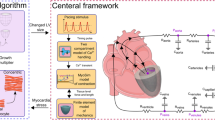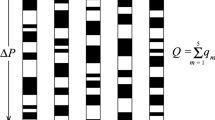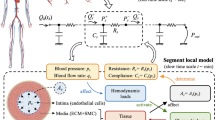Abstract
During development, the heart begins pumping as a valveless multilayered tube capable of driving blood flow throughout the embryonic vasculature. The mechanical properties and how they interface with pumping function are not well-defined at this stage. Here, we evaluate pumping patterns using a fluid–structure interaction computational model, combined with experimental data and an energetic analysis to investigate myocardial mechanical properties. Through this work, we propose that a myocardium modeled as a Neo-Hookean material with a material constant on the order of 10 kPa is necessary for the heart tube to function with an optimal pressure and cardiac output.






Similar content being viewed by others
References:
Abdul-Wajid S, Demarest BL, Yost HJ (2018) Loss of embryonic neural crest derived cardiomyocytes causes adult onset hypertrophic cardiomyopathy in zebrafish. Nat Commun 9:1–11
Avrahami I, Gharib M (2008) Computational studies of resonance wave pumping in compliant tubes. J Fluid Mech 608:139–160
Bajaj P, Tang X, Saif TA, Bashir R (2010) Stiffness of the substrate influences the phenotype of embryonic chicken cardiac myocytes. J Biomed Mater Res, Part A 95:1261–1269
Bark DL Jr, Johnson B, Garrity D, Dasi LP (2017) Valveless pumping mechanics of the embryonic heart during cardiac looping: pressure and flow through micro-PIV. J Biomech 50:50–55
Battista NA, Miller LA (2017) Bifurcations in valveless pumping techniques from a coupled fluid-structure-electrophysiology model in heart development. arXiv preprint https://arxiv.org/abs/1709.05264
Battista NA, Lane AN, Miller LA (2017) On the dynamic suction pumping of blood cells in tubular hearts. In: Women in mathematical biology. Springer, pp 211–231
Bhana B, Iyer RK, Chen WLK et al (2010) Influence of substrate stiffness on the phenotype of heart cells. Biotechnol Bioeng 105:1148–1160
Bovo E, Dvornikov AV, Mazurek SR et al (2013) Mechanisms of Ca 2+ handling in zebrafish ventricular myocytes. Pflügers Archiv-Eur J Physiol 465:1775–1784
Bulk A, Bark D Jr, Johnson B et al (2016) Mechanisms influencing retrograde flow in the atrioventricular canal during early embryonic cardiogenesis. J Biomech 49:3162–3167
De Vita R, Grange R, Nardinocchi P, Teresi L (2017) Mathematical model for isometric and isotonic muscle contractions. J Theor Biol 425:1–10
Edwards JN, Blatter LA (2013) Dysfunctional intracellular calcium cycling in cardiac alternans. In: Proceedings of the Australian physiological society. pp 39–48
Engler AJ, Carag-Krieger C, Johnson CP et al (2008) Embryonic cardiomyocytes beat best on a matrix with heart-like elasticity: scar-like rigidity inhibits beating. J Cell Sci 121:3794–3802
Forouhar AS, Liebling M, Hickerson A et al (2006) The embryonic vertebrate heart tube is a dynamic suction pump. Science 312:751–753
Frank O (1926) Die theorie der pulswellen. Z Biol 85:91–130
Gendernalik A, Zebhi B, Ahuja N et al (2021) In vivo pressurization of the zebrafish embryonic heart as a tool to characterize tissue properties during development. Ann Biomed Eng 49:1–12
Goenezen S, Rennie MY, Rugonyi S (2012) Biomechanics of early cardiac development. Biomech Model Mechanobiol 11:1187–1204
Hickerson AI, Gharib M (2006) On the resonance of a pliant tube as a mechanism for valveless pumping. J Fluid Mech 555:141
Hickerson AI, Rinderknecht D, Gharib M (2005) Experimental study of the behavior of a valveless impedance pump. Exp Fluids 38:534–540
Hu N, Keller BB (1995) Relationship of simultaneous atrial and ventricular pressures in stage 16–27 chick embryos. Am J Physiol-Heart Circ Physiol 269:H1359–H1362
Jacot JG, McCulloch AD, Omens JH (2008) Substrate stiffness affects the functional maturation of neonatal rat ventricular myocytes. Biophys J 95:3479–3487
Johnson BM, Garrity DM, Dasi LP (2013) The transitional cardiac pumping mechanics in the embryonic heart. Cardiovasc Eng Technol 4:246–255
Kimmel CB, Ballard WW, Kimmel SR et al (1995) Stages of embryonic development of the zebrafish. Dev Dyn 203:253–310
Kozlovsky P, Bryson-Richardson RJ, Jaffa AJ et al (2016) The driving mechanism for unidirectional blood flow in the tubular embryonic heart. Ann Biomed Eng 44:3069–3083
Lee J, Moghadam ME, Kung E et al (2013) Moving domain computational fluid dynamics to interface with an embryonic model of cardiac morphogenesis. PloS one 8:72924
Lin Y-F, Swinburne I, Yelon D (2012) Multiple influences of blood flow on cardiomyocyte hypertrophy in the embryonic zebrafish heart. Dev Biol 362:242–253
Liu A, Yin X, Shi L, Li P, Thornburg KL, Wang R, Rugonyi S, Merks RMH (2012) Biomechanics of the chick embryonic heart outflow tract at HH18 using 4D optical coherence tomography imaging and computational modeling. PLoS ONE 7(7):e40869. https://doi.org/10.1371/journal.pone.0040869
Loumes L, Avrahami I, Gharib M (2008) Resonant pumping in a multilayer impedance pump. Phys Fluids 20:023103
Malone MH, Sciaky N, Stalheim L et al (2007) Laser-scanning velocimetry: a confocal microscopy method for quantitative measurement of cardiovascular performance in zebrafish embryos and larvae. BMC Biotechnol 7:1–11
Männer J, Wessel A, Yelbuz TM (2010) How does the tubular embryonic heart work? Looking for the physical mechanism generating unidirectional blood flow in the valveless embryonic heart tube. Dev Dyn 239:1035–1046
Rideout VC (1991) Mathematical and computer modeling of physiological systems. Prentice Hall, Englewood Cliffs
Rodriguez AG, Han SJ, Regnier M, Sniadecki NJ (2011) Substrate stiffness increases twitch power of neonatal cardiomyocytes in correlation with changes in myofibril structure and intracellular calcium. Biophys J 101:2455–2464
Santhanakrishnan A, Miller LA (2011) Fluid dynamics of heart development. Cell Biochem Biophys 61:1–22
Schneider CA, Rasband WS, Eliceiri KW (2012) NIH Image to ImageJ: 25 years of image analysis. Nat Methods 9:671–675
Taber LA, Chabert S (2002) Theoretical and experimental study of growth and remodeling in the developing heart. Biomech Model Mechanobiol 1:29–43
Taber LA, Zhang J, Perucchio R (2007) Computational model for the transition from peristaltic to pulsatile flow in the embryonic heart tube. J Biomech Eng 129:441–9
von Dassow M, Davidson LA (2009) Natural variation in embryo mechanics: gastrulation in Xenopus laevis is highly robust to variation in tissue stiffness. Dev Dyn Off Publ Am Assoc Anat 238:2–18
Waldrop L, Miller L (2016) Large-amplitude, short-wave peristalsis and its implications for transport. Biomech Model Mechanobiol 15:629–642
Yoshigi M, Keller BB (1997) Characterization of embryonic aortic impedance with lumped parameter models. Am J Physiol-Heart Circ Physiol 273:H19–H27
Young JL, Engler AJ (2011) Hydrogels with time-dependent material properties enhance cardiomyocyte differentiation in vitro. Biomaterials 32:1002–1009
Yuryev M, Pellegrino C, Jokinen V et al (2016) In vivo calcium imaging of evoked calcium waves in the embryonic cortex. Front Cell Neurosci 9:500
Zamir EA, Taber LA (2004) Material properties and residual stress in the stage 12 chick heart during cardiac looping. J Biomech Eng 126:823–830
Zamir EA, Srinivasan V, Perucchio R, Taber LA (2003) Mechanical asymmetry in the embryonic chick heart during looping. Ann Biomed Eng 31:1327–1336
Zhao Y, Srivastava D (2007) A developmental view of microRNA function. Trends Biochem Sci 32:189–197
Author information
Authors and Affiliations
Corresponding author
Additional information
Publisher's Note
Springer Nature remains neutral with regard to jurisdictional claims in published maps and institutional affiliations.
Supplementary Information
Below is the link to the electronic supplementary material.
Supplementary file2 (MP4 915 KB)
Rights and permissions
About this article
Cite this article
Sharifi, A., Gendernalik, A., Garrity, D. et al. Valveless pumping behavior of the simulated embryonic heart tube as a function of contractile patterns and myocardial stiffness. Biomech Model Mechanobiol 20, 2001–2012 (2021). https://doi.org/10.1007/s10237-021-01489-7
Received:
Accepted:
Published:
Issue Date:
DOI: https://doi.org/10.1007/s10237-021-01489-7




